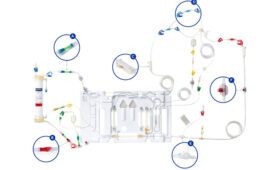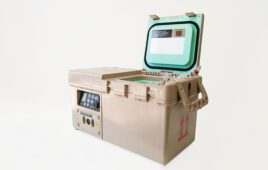By Dave Nichols, Account Manager at Century Refrigeration

Dave Nichols at Century Refrigeration working on a refrigeration system.
Large-scale blood product storage presents unique refrigeration challenges that require a great deal of expertise in system design. Customized refrigeration solutions engineered specifically for blood storage applications are necessary in order to meet the application’s unique demands. For example, cooling equipment must achieve extremely low temperatures and maintain these temperatures steadily in order to comply with regulatory requirements and avoid contaminating this very high-value product. Additionally, blood storage refrigeration systems must use safe refrigerants, be designed for maximum reliability and redundancy, and be easy to maintain.
Extremely low-temperature requirements demand specialized equipment
Refrigeration systems for blood product storage face unique demands, but by far the most critical is achieving the consistent low temperature required by regulatory guidelines.
Centers for Disease Control (CDC) guidelines state that blood plasma, for example, can be stored for up to 3-7 years under proper conditions, which is defined as stored at a consistent -35 to -40°F. These extremely low temperatures must be maintained constantly, even during maintenance. Plasma storage refrigeration compressors must reliably operate at -50°F, since compressors must operate at 10°F below the desired storage temperature. Refrigeration systems, therefore, must be designed with components capable of operation in such extreme temperatures.
For example, the coils used must function at -50 °F, while being subjected to periodic defrosting at temperatures of roughly 100°F, which leads to a great deal of expansion and contraction. The coils must be able to cope with these temperature extremes and still provide the necessary performance and reliability. As a result, coils for these applications are typically designed with as few as four fins per inch. Condenser coils are also designed as low as 8 fins per inch, far lower than in standard refrigeration equipment. The reduced number of fins make the coils less likely to clog and easier to clean. In addition, the selection of fan motors with special low-temperature grease is a requirement. To lend additional strength and reliability at these temperatures, the copper tubing typically used in plasma storage cooling systems may be as much as twice as thick as in standard refrigeration equipment.
Avoiding damage and contamination with specialized refrigerants
Beyond temperature requirements, blood products are also very sensitive to chemical damage and contamination. As a result, refrigeration systems for these applications require the use of refrigerants that are unlikely to leak and cause costly damage. The refrigerant, therefore, must be deemed safe for use in medical cooling systems. Ammonia is an example of a poor choice of refrigerant for blood plasma storage applications. If ammonia were to leak into the plasma storage area of the refrigeration system, all the affected plasma could be contaminated and lost. This is far too costly a risk to take, especially for large-scale blood product storage applications.
The extremely low-temperature demands of blood plasma and other blood product storage must also be considered during refrigerant selection since many refrigerants cannot flow well at such low temperatures. Refrigerants other than ammonia, including R-507, can perform appropriately at the low temperatures required and also pose a lower safety and contamination risk.

A Century Refrigeration customized refrigeration system for blood and plasma storage facilities that required ultra-low room temperatures of -40° F.
Experts consider reliability and maintenance in system design
In many other refrigeration applications, cooling systems are designed as a single, large, central unit. This design is not a good choice for blood product storage, however, as small maintenance issues can lead to large-scale product loss. If the compressor in such a unit fails or even begins to run below its intended capacity, the entire facility can go down, leading to the loss of a large amount of high-value blood products.
Dividing the cooling among a number of smaller compressors is a far more suitable design for blood storage applications. In doing so, system designers significantly reduce the overall impact of a single compressor losing efficacy or failing entirely. In addition, full redundancy is ideal in blood plasma and other blood product storage applications, given the extremely demanding and precise CDC regulations they are subject to and the high value of the products themselves. Fully redundant systems allow for maintenance to take place as necessary, without concerns over system failure. Systems with a number of smaller compressors are easier and less expensive to make fully redundant than large, single-unit systems.
In addition, this design reduces overall maintenance demands and makes it easier for end users to perform necessary maintenance. As a result, the system can be restored to functionality quickly in the event of most issues, without having to wait for the OEM to send service technicians. Effective monitoring systems add to the systems’ reliability and low downtime, enabling operators to detect issues early on.
Customization is the best option
The demands of blood product storage are too great, and ultimately too application-specific, to support the use of off-the-shelf refrigeration technology. To guarantee success, blood product storage refrigeration systems should be custom-designed, with individual components custom-selected and sized to sustain the necessary low temperatures, avoid contamination and product loss, and simplify maintenance.
When designing new or replacement blood product storage cooling systems, it is always best to work with a refrigeration technology company that can provide expert, customized design, manufacturing, and support.
Putting it all together: A brief case study
Century Refrigeration (located in Pryor, Okla.) customized a system for a blood and plasma storage facility that required ultra-low room temperatures of -40° F. The facility had been operating using an ammonia refrigeration system, and the owner had health and safety concerns about using ammonia, similar to those described above. The ammonia system presented too great of a potential for loss of product inventories in the event of a leak in the refrigeration system, and so a decision was made to replace the system.
The condensing units had to be installed in limited available space. Unit coolers had to be installed in the penthouse, requiring refrigerated air to be distributed over 80 feet with a 90° turn down, creating a high static pressure application.
To reduce the risks associated with the ammonia system and meet the limited space requirements, Century Refrigeration supplied a new system that uses ten dual-circuited condensing units with 30HP two-stage Bitzer compressors. The compressors operate on refrigerant 507a, minimizing potential product loss from a refrigerant leak. The Century condensing units maximized system redundancy and reliability while minimizing footprint. They were matched with dual circuit Century PFE blast freezer unit coolers with Ultracase™ coils utilizing copper tube sheets. The system used amperage monitoring and pressure/temperature transducers to provide overall system control. The control and monitoring system was designed to be completely compatible with the existing building automation system. The resulting system had built in redundancy, with 20 percent additional standby capacity.
With the expertise of Century Refrigeration’s system designers, this customer was able to replace their existing system, with its inherent risks of product loss, with a far superior system designed precisely for the application. The Century Refrigeration system has proven to provide benefits of product safety, reliability, maintenance ease, and performance over the prior system.




